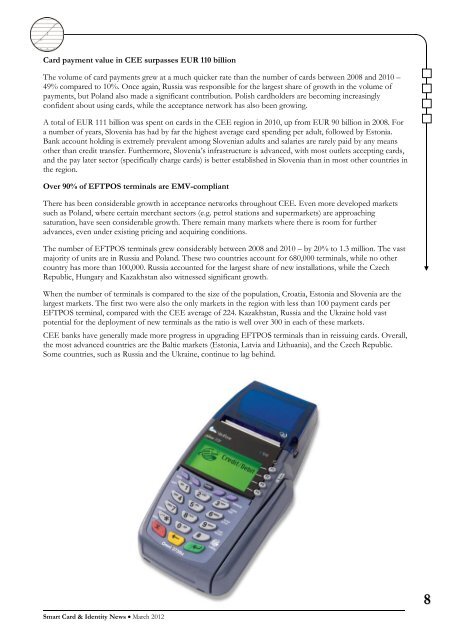Smart Card & Identity News A New Flavour for eCash
Smart Card & Identity News A New Flavour for eCash
Smart Card & Identity News A New Flavour for eCash
You also want an ePaper? Increase the reach of your titles
YUMPU automatically turns print PDFs into web optimized ePapers that Google loves.
<strong>Card</strong> payment value in CEE surpasses EUR 110 billion<br />
The volume of card payments grew at a much quicker rate than the number of cards between 2008 and 2010 –<br />
49% compared to 10%. Once again, Russia was responsible <strong>for</strong> the largest share of growth in the volume of<br />
payments, but Poland also made a significant contribution. Polish cardholders are becoming increasingly<br />
confident about using cards, while the acceptance network has also been growing.<br />
A total of EUR 111 billion was spent on cards in the CEE region in 2010, up from EUR 90 billion in 2008. For<br />
a number of years, Slovenia has had by far the highest average card spending per adult, followed by Estonia.<br />
Bank account holding is extremely prevalent among Slovenian adults and salaries are rarely paid by any means<br />
other than credit transfer. Furthermore, Slovenia’s infrastructure is advanced, with most outlets accepting cards,<br />
and the pay later sector (specifically charge cards) is better established in Slovenia than in most other countries in<br />
the region.<br />
Over 90% of EFTPOS terminals are EMV-compliant<br />
There has been considerable growth in acceptance networks throughout CEE. Even more developed markets<br />
such as Poland, where certain merchant sectors (e.g. petrol stations and supermarkets) are approaching<br />
saturation, have seen considerable growth. There remain many markets where there is room <strong>for</strong> further<br />
advances, even under existing pricing and acquiring conditions.<br />
The number of EFTPOS terminals grew considerably between 2008 and 2010 – by 20% to 1.3 million. The vast<br />
majority of units are in Russia and Poland. These two countries account <strong>for</strong> 680,000 terminals, while no other<br />
country has more than 100,000. Russia accounted <strong>for</strong> the largest share of new installations, while the Czech<br />
Republic, Hungary and Kazakhstan also witnessed significant growth.<br />
When the number of terminals is compared to the size of the population, Croatia, Estonia and Slovenia are the<br />
largest markets. The first two were also the only markets in the region with less than 100 payment cards per<br />
EFTPOS terminal, compared with the CEE average of 224. Kazakhstan, Russia and the Ukraine hold vast<br />
potential <strong>for</strong> the deployment of new terminals as the ratio is well over 300 in each of these markets.<br />
CEE banks have generally made more progress in upgrading EFTPOS terminals than in reissuing cards. Overall,<br />
the most advanced countries are the Baltic markets (Estonia, Latvia and Lithuania), and the Czech Republic.<br />
Some countries, such as Russia and the Ukraine, continue to lag behind.<br />
8<br />
<strong>Smart</strong> <strong>Card</strong> & <strong>Identity</strong> <strong><strong>New</strong>s</strong> • March 2012
















